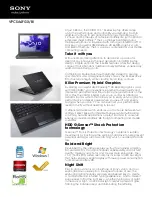
Glossary
Portégé A100
3
Portégé A100
Version
2
Last Saved on
25.11.2003 16:25
25.11.2003 16:0518.11.2003 14:19
ENGLISH using Palau30 Online.dot –– Printed on
28.11.2003
25.11.2003
as
C
cache memory:
High speed memory which stores data that increases
processor speed and data transfer rate. When the CPU reads data
from main memory, it stores a copy of this data in cache memory.
The next time the CPU needs that same data, it looks for it in the
cache memory rather than the main memory, which saves time.
The computer has two cache levels. Level one is incorporated into
the processor and level two resides in external memory.
capacity:
The amount of data that can be stored on a magnetic storage
device such as a diskette (floppy disk) or hard disk. It is usually
described in terms of kilobytes (KB), where one KB = 1024 bytes
and megabytes (MB), where one MB = 1024 KB.
card:
Synonym for board
. See
board.
CardBus:
An industry standard bus for 32-bit PC Cards.
CD-ROM:
A Compact Disc-Read Only Memory is a high capacity disc
that can be read from but not written to. The CD-ROM drive uses a
laser, rather than magnetic heads, to read data from the disc.
CD-RW:
A Compact Disc-Read/Write disc can be rewritten many times.
character:
Any letter, number, punctuation mark, or symbol used by the
computer. Also synonymous with byte.
chassis:
The frame containing the computer.
chip:
A small semiconductor containing computer logic and circuitry for
processing, memory, input/output functions and controlling other
chips.
CMOS:
Complementary Metal-Oxide Semiconductor. An electronic circuit
fabricated on a silicon wafer that requires very little power.
Integrated circuits implemented in CMOS technology can be
tightly packaged and are highly reliable.
cold start:
Starting a computer that is currently off (turning on the power).
COM1, COM2, COM3 and COM4:
The names assigned to the serial and
communication ports.
commands:
Instructions you enter at the terminal keyboard that direct
the actions of the computer or its peripheral devices.
communications:
The means by which a computer transmits and
receives data to and from another computer or device. See
parallel
interface; serial interface
.
compatibility:
1) The ability of one computer to accept and process data
in the same manner as another computer without modifying the
data or the media upon which it is being transferred. 2) the ability
of one device to connect to or communicate with another system
or component.
components:
Elements or parts (of a system) which make up the whole
(system).
computer program:
A set of instructions written for a computer that
enable it to achieve a desired result.














































